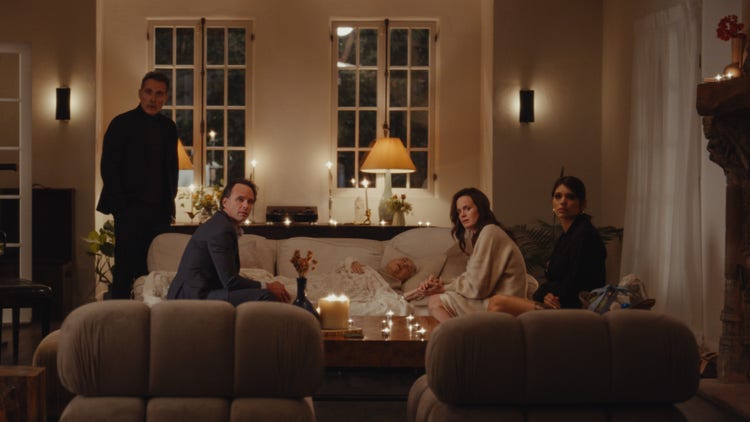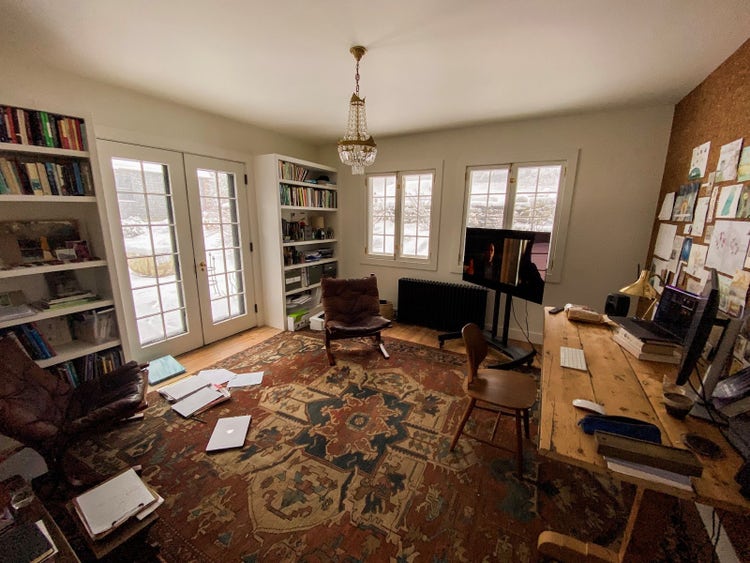Editor Patrick Walsh on creating SXSW Film “The Uninvited” with Adobe Premiere Pro

In the SXSW film, “The Uninvited”, a stranger named Helen crashes a house party and claims residence there. Helen possesses intimate knowledge of the house and its guests, offering revelations during the party that spark drama, comedy, and hidden truths, compelling the homeowner Rose to confront her past, future, and the desire for change.
Editor Patrick Walsh shares how Adobe Creative Cloud tools, including Productions in Premiere Pro and Adobe Frame.io, were invaluable during post production.
“The Uninvited” premieres at SXSW on March 11.
How and where did you first learn to edit?
Editing has been a long, constantly evolving road for me — I got an initial spark as a teenager when I made my own little documentary version of “Dazed & Confused” in iMovie with footage from our last day of high school. I remember feeling an immediate connection to the power of manipulating pictures and sounds to create a third new entity. I really fell for editing while studying film at university. It felt instinctive to me — something just clicked. I was so galvanized by it, that I ended up cutting a lot of my classmate’s films as well as my own, all with a cracked version of an older editing software! Afterwards, spending my twenties as an in-house assistant editor under some of the most talented editors and directors in London felt like a PhD in filmmaking I never knew I needed. It would’ve been hard not to learn something about the process of storytelling when you’re in rooms with people like Jonathan Glazer and Paul Watts (“The Zone of Interest”, “Under The Skin”). I’ve found editing to be a primarily self-taught discipline where you never stop learning no matter how long you’ve been doing it.
How do you begin a project/set up your workspace?
Years as an assistant have ingrained in me the need to be as organized as possible! It’s not sexy or creative, but it’s so vital. It’s really all that separates amateurs from professionals. I’m really strict with myself about clearly labeling folders and bins and everything being in its right place so that I’m not lost or slowed-down by any disorganization once I’m fully immersed in the actual creative process. My feature film workspace is heavily inspired by editors like Eddie Hamilton and Kirk Baxter who’ve been generous enough to share screen grabs of their project layouts. I’ve stolen all their best practices and Frankenstein’d them into a hybrid that feels bulletproof! It’s so important not to just share timelines, but also projects and bin layouts too!
Tell us about a favorite scene or moment from this project and why it stands out to you.
We had an opportunity to bridge the gap between the second and third acts with something completely tonally different to the rest of the film. In the script, there’s an explosive fight between Rose (Elizabeth Reaser) and Sammy (Walton Goggins) who storm off in separate directions, and quite a lot of the immediate fallout that was scripted had to be abandoned due to budget constraints.
One afternoon, I stumbled across Louis Armstrong’s “Sleepy Time Down South” while looking for background party music. I started to build a montage around it with the limited footage we had to fill that moment — and it just worked. It helped solve things emotionally and chronologically, and it subconsciously signposted to the audience that we were approaching the final act. I was able to lean on my experience in music videos to assemble it quite quickly, and not much changed between that first assembly and picture lock. In a film that is so dialogue-intense, where Nadia had such precise intentions for each scene, it was gratifying to show her something that both surprised her and satisfied her emotional intent for that bridge in the story. I think the resolution of that montage is both our favorite moments in the film.
What were some specific post-production challenges you faced that were unique to your project? How did you go about solving them?
I had to be my own assistant on “The Uninvited”. This is the second feature film I’ve worked on where I was assembling in London while the crew was shooting in LA. I relied on our digital imaging technician, Mateo Nikolav, to transcode, sync, and upload the dailies overnight via Frame.io, so they were ready for me to download and organize all of the previous day’s footage each morning. He was working with 6K Sony Venice X-OCN ST files, transcoding down to 2K ProResLT.mov’s, so some mornings there were overlaps in our timings. I still find that doing the ‘boring’ upfront legwork of an assistant for an hour or so each morning is actually a really good way of getting familiar with the footage, but with such an intense shooting schedule (just 15 days), they were capturing so much each day that I was just able to keep up to camera by the skin of my teeth.
What Adobe tools did you use on this project, and why did you originally choose them? Were there any other third party tools that helped enhance your workflow?
I used Productions in Adobe Premiere Pro, which has been a game changer in recent years. I assisted on a feature film a while ago where we’d have to wait 20 minutes for the project just to open, but Premiere Pro Productions allows for an entire feature film to run quickly and smoothly. Premiere Pro has been my go-to NLE for a while now as I feel it can keep up with my speed of thought as I work. There’s very little that gets in the way between an idea in the room and executing it in the timeline. Every now and then, I used Dynamic Link to send a shot to Adobe After Effects for stabilization with the Mocha plug-in, or if there was a fiddly mask or split screen comp that needed a bit more love and attention. Having comps update automatically in my Premiere Pro timeline is an invaluable time-saver — especially on projects where you’re a one-man band and you don’t have the time to constantly export and import tweaked shots.
In addition to using the blazing Frame.io Transfer app to upload and download footage, I used Frame.io to share dailies with Nadia and the producers during the shoot to reassure everyone that they were getting everything despite the tight schedule. I also used it to share my scene assemblies for everyone to watch. By the time we got to the notes stage, it was an indispensable tool that got us all on the same page — Nadia was in New York, I was in London, and the producers were in LA. Being able to leave precise notes on exact frames takes so much ambiguity out of the discussion and leaves no room for misinterpretation. Gone are the days of endless email chains where notes can get so easily lost in the mess. Having the Frame.io extension window open within Premiere Pro is so much more convenient than jumping between an email or PDF and back again.
If you could share one tip about Premiere Pro, what would it be?
I’d say to lean into its customizable aspects as much as possible. Get it to work for you as conveniently as you can, rather than feel like you need to bend to its default settings — make up your own keyboard shortcuts, set up your own export settings, and build your own workspace templates! The less time and brain energy spent thinking about how you’re going to creatively solve a problem rather than just doing it, the more effective, liberated filmmaker you’ll become!
Who is your creative inspiration and why?
I’m always inspired by the ways in which David Fincher and his post team continue to strive and push the form of audiovisual storytelling, even though they’ve been doing this for over 30 years. I admire how they ignore established conventions. Their attitude of “just because this is how something has always been done doesn’t mean it’s how it should be done” is something I try to live up to. They capitalize on technological advances to streamline how they work, and eliminate as much paraphernalia as possible between an idea and its execution — but technology is always driving story and character.
There’s an excellent deep-dive with Kirk and Angus on the bonus features on “The Social Network” blu-ray, which cemented in my mind that editing is what I wanted to dedicate myself to. It’s fascinating to watch their process and hear them talk about approach and methodology. Successful filmmaking is too often distilled down to ambiguous phrases like “magic” or “fairy dust” or "serendipity," but the simple revelation is that it takes a lot of hard work by many skilled craftspeople over a long period of time.
What’s the toughest thing you’ve had to face in your career, and how did you overcome it? What advice do you have for aspiring filmmakers or content creators?
Despite a lot of hard work and dedication, “The Uninvited” turned out to be a slower editing process than we originally thought. Nadia and I were carefully fine-cutting each scene from the get-go, and there was quite a bit of experimentation, which I guess for an independent low-budget film wasn’t ideal. I was originally contracted for 12 weeks, which then grew to 16 weeks, then 20. By that point, I think the producers were worried that we were just going to keep going and going indefinitely, so they chose to bring in another set of eyes to get the film over the finish line as quickly as possible.
Todd Zelin came in for three or four weeks and took over, which I can’t pretend wasn’t a kick in the gut, but he really got the film moving in the least-destructive way possible and got things back on schedule. I know it’s quite a common occurrence in this industry, and you’re reassured it’s not personal, but I still felt like I’d let the team down a little by not picture-locking sooner. I actually ended up jumping back into the film after Todd’s time ran out too, and Nadia and I kept chipping away for many more weeks to tend to various scenes she felt still weren’t quite there. In the end, I saw the film over the finish line after all, including overseeing the sound mix with Tristan Bayliss at Gigantic Studios and finalizing the last online touches with CinemaMachina. I’ve now seen firsthand that films aren’t finished, they’re abandoned.
Share a photo of where you work. What’s your favorite thing about your workspace and why?
This is Nadia’s home office that we transformed into a makeshift edit suite. We more than made do with a computer, an external monitor, studio speakers, and a 4K TV. I lived with Nadia and Walton for a couple of months in upstate New York in the depths of winter, which was bitterly cold but a beautiful environment to both live and work in. It had potential “The Shining” vibes, but I was welcomed in with open arms. There was an endless supply of coffee and attention from their dog Lucy, and I was fattened-up on Nadia’s amazing home cooking. I felt more like a member of the family than a co-worker!

Image Source: Patrick Walsh, “The Uninvited” editor